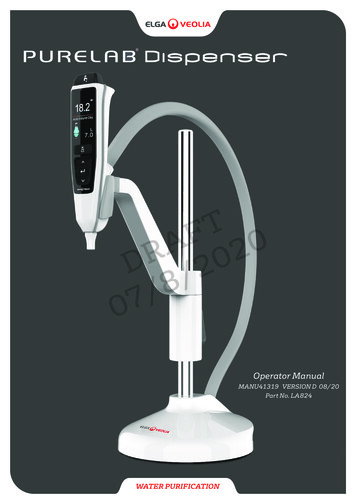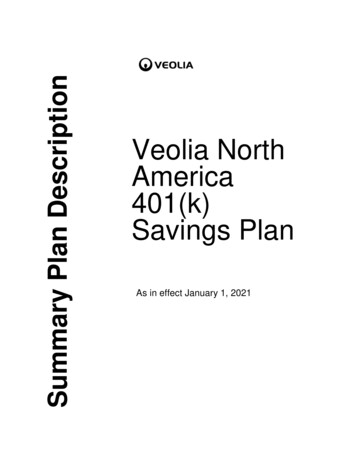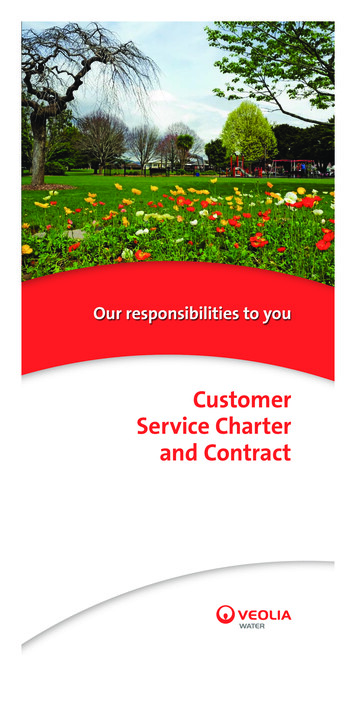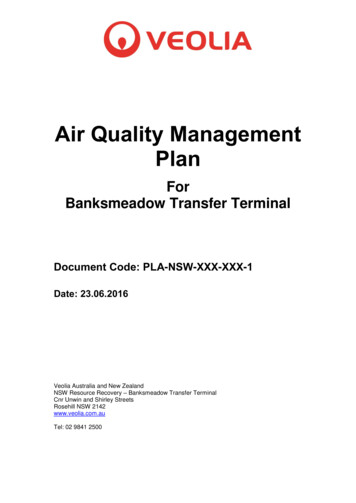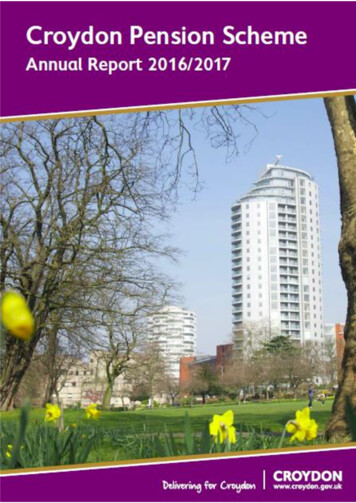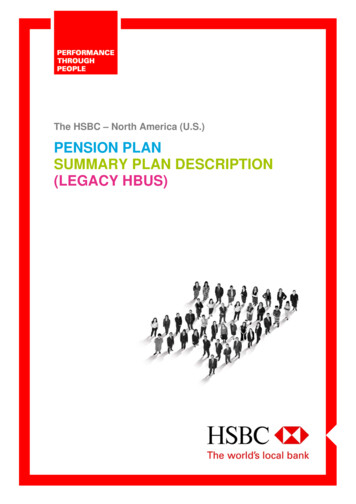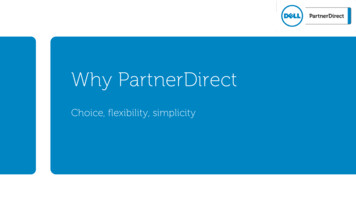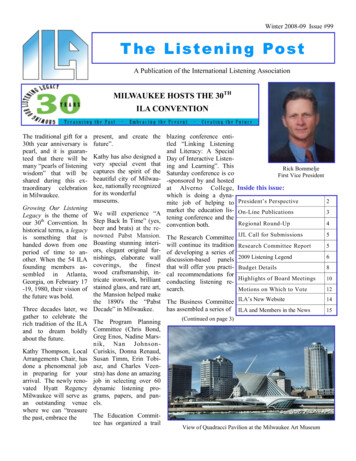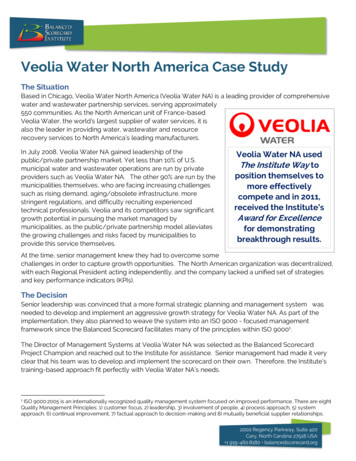
Transcription
Veolia Water North America Case StudyThe SituationBased in Chicago, Veolia Water North America (Veolia Water NA) is a leading provider of comprehensivewater and wastewater partnership services, serving approximately550 communities. As the North American unit of France-basedVeolia Water, the world’s largest supplier of water services, it isalso the leader in providing water, wastewater and resourcerecovery services to North America’s leading manufacturers.In July 2008, Veolia Water NA gained leadership of thepublic/private partnership market. Yet less than 10% of U.S.municipal water and wastewater operations are run by privateproviders such as Veolia Water NA. The other 90% are run by themunicipalities themselves, who are facing increasing challengessuch as rising demand, aging/obsolete infrastructure, morestringent regulations, and difficulty recruiting experiencedtechnical professionals. Veolia and its competitors saw significantgrowth potential in pursuing the market managed bymunicipalities, as the public/private partnership model alleviatesthe growing challenges and risks faced by municipalities toprovide this service themselves.Veolia Water NA usedThe Institute Way toposition themselves tomore effectivelycompete and in 2011,received the Institute’sAward for Excellencefor demonstratingbreakthrough results.At the time, senior management knew they had to overcome somechallenges in order to capture growth opportunities. The North American organization was decentralized,with each Regional President acting independently, and the company lacked a unified set of strategiesand key performance indicators (KPIs).The DecisionSenior leadership was convinced that a more formal strategic planning and management system wasneeded to develop and implement an aggressive growth strategy for Veolia Water NA. As part of theimplementation, they also planned to weave the system into an ISO 9000 - focused managementframework since the Balanced Scorecard facilitates many of the principles within ISO 90001.The Director of Management Systems at Veolia Water NA was selected as the Balanced ScorecardProject Champion and reached out to the Institute for assistance. Senior management had made it veryclear that his team was to develop and implement the scorecard on their own. Therefore, the Institute’straining-based approach fit perfectly with Veolia Water NA’s needs.1ISO 9000:2005 is an internationally recognized quality management system focused on improved performance. There are eightQuality Management Principles: 1) customer focus, 2) leadership, 3) involvement of people, 4) process approach, 5) systemapproach, 6) continual improvement, 7) factual approach to decision-making and 8) mutually beneficial supplier relationships.2000 Regency Parkway, Suite 420Cary, North Carolina 27518 USA 1 919-460.8180 balancedscorecard.org
Program Launch: Sponsorship and Engaged LeadershipVeolia Water NA’s President and CEO served as the executive sponsor for the program. The VicePresident of Environmental Health and Safety (EHS) at Veolia Water was added to the team in order toeventually transition to the Project Champion role.A Senior Management Team (SMT) was formed, which included regional presidents and corporateexecutives (e.g., HR, Legal, Business Development, etc.).Program Launch: Communication and Change ManagementDuring the initial workshops, the leadership team needed to gain buy-in from the other SMT members.Many of the members were familiar with the Balanced Scorecard management philosophy, but knew theirorganizational challenges did not bode well for the project’s success. The right executive advocates,communication and timing were critical for change.A letter from the CEO to all employees communicated the Balanced Scorecard and initiated thecommunications strategy. The SMT assumed the communications responsibilities, with support fromVeolia’s Communications group. The senior management team’s enthusiasm, drive and assertivenesscreated the sense of urgency in the organization that was needed for change.As part of the communications effort, Veolia used compelling graphics to communicate their strategy.Figure 1 below is an example used at a manager’s meeting to communicate FY10 priorities in context ofstrategy.Figure 1: Communication Graphic for Veolia Water NA2000 Regency Parkway, Suite 420Cary, North Carolina 27518 USA 1 919-460.8180 balancedscorecard.org2
Program Launch: Plan the ProjectSince Veolia wanted to quickly build in-house capacity and develop their scorecard on their own, theirproject plan focused on a series of training workshops followed by development sessions. Table 1 depictsVeolia Water NA’s project plan.Table 2: Veolia Water NA’s Project PlanStep 1: AssessmentOne of the initial sub-steps—conducting a SWOT Analysis to assess the organization’s strengths,weaknesses, opportunities, and threats—was already part of the existing strategic planning process so itwas completed in a timely manner. Institute consultants emphasized how the SWOT Analysis is integral toseveral future steps in the BSI Nine Steps to Success . For many SMT members, it would be the first timethey would see the link between the SWOT Analysis and formulating a strategy.A team member took the initial cut at writing the company’s mission and vision. There was a collaborativediscussion lasting several hours debating the wording and meaning of these two strategic components.Table 2 shows the final Veolia Water NA mission and vision.Table 2: Veolia Water NA Mission and VisionThe SMT decided to use the Veolia Environment core values, instead of creating new ones.2000 Regency Parkway, Suite 420Cary, North Carolina 27518 USA 1 919-460.8180 balancedscorecard.org3
Documenting Veolia Water NA customers and stakeholders was a simple process. Customers aremunicipal clients (City Managers, Public Works Departments and Utility Commissioners) and industrialclients (Refineries, Chemical Processing, Automotive, Primary Metals and Food & Beverage – to name afew).Stakeholders are defined as the customers, plus regulatory agencies (e.g., OSHA, EPA, etc.) and theirparent company (Veolia Environment).Step 2: StrategyThe Institute consultant explained each strategic component then facilitated a working session with theSMT to define the component and reinforce the teachings. This approach worked well in the developmentof the strategic themes. The strategic themes, shown in Table 3, highlighted the requirements to achieveVeolia’s Vision.Table 3: Veolia Water NA Strategic ThemesVeolia Water NA knew it would need to reorganize itself to capture growth in the market. This resulted ina tight inter-relationship between the strategic themes. Veolia wanted to be the water systemmanagement provider of choice for municipalities. So, they had to develop innovative ways to helpmunicipalities take on capital improvements to their system, which required leveraging partnerships withVeolia’s sister companies to provide end-to-end service, increase revenues, and decrease operatingcosts.Veolia Water NA decided to use the general perspectives of Learning & Growth, Business Processes,Customer, and Financial. Financial was placed on top above Customer, as is typical in commercialindustry. The Team felt these perspectives were the right lenses for developing a sustainable,comprehensive strategy map.Step 3: Strategic ObjectivesLaying out the matrix of strategic themes and perspectives along with the SWOT Analysis jump-startedthe SMT’s brainstorming of objectives. Instead of separately identifying objectives for each strategictheme, Veolia Water NA streamlined the process and used a matrix approach. The completed matrix wasa precursor to the strategy map they would create. When considering the “Innovative Solutions &Partnerships” strategic theme, the team identified objectives such as “Increase and Improve Portfolio ofInnovative Solutions” in the “Business Process” perspective. This led to creating objectives in the “Learning& Growth” perspective that would make innovation possible (e.g., an objective focused on understandingmarket trends).2000 Regency Parkway, Suite 420Cary, North Carolina 27518 USA 1 919-460.8180 balancedscorecard.org4
The team wrote objective commentary to make sure everyone was on the same page and to referencedown the road in the process. The 13 objectives answered the question of how Veolia Water NA wouldachieve its vision by creating action around the strategic themes.Step 4: Strategy MappingCreation of the actual strategy map from the matrix of objectives was an interesting and iterative processfor Veolia Water NA. The SMT went into this step with the expectation that the end product would tell theorganization’s story and be easy to understand for project managers at the various sites. Using awhiteboard, they began drawing lines between objectives to show cause-and-effect linkages. Theydecided to group the “Learning and Growth” perspective objectives together because they were at thefoundation of the strategy execution. While drafting the Strategy Map, the SMT kept in mind the order ofthe strategic themes at the top of the map: High Growth * Innovation * Operational Excellence. They thenorganized the objectives under applicable strategic themes or between themes if they integrated multiplestrategic themes. For example, the objective “Increase and Improve Portfolio of Innovative Solutions” inthe “Business Process” perspective addressed both the “Sustainable, Profitable High Growth” and“Innovative Solutions & Partnerships” strategic themes so it was aligned between these themes on themap. When the SMT felt they had a solid strategy map, they took a day off and came back to it withcleared minds to make sure it still made sense.The team created a PowerPoint presentation of the strategy map that had pop-ups of the objectivecommentary. This presentation served as a basis for communicating the strategy to their stakeholders.Step 5: Measures and TargetsVeolia Water NA refers to performance measures as KPIs. During the early planning phases, theleadership team developed criteria for selecting KPIs, which was accepted by the SMT. Criteria for KPIswas as follows: Meaningful (and controllable)Valid (measuring the right things for the intended results)VerifiableUseful information providedEasy to collectThe SMT was expanded to include subject matter experts in Step 5. The team locked themselves awayand went through each objective one at a time (from the bottom to the top) to brainstorm a list of KPIs.Then, they went back through the list to refine it according to their accepted criteria.Next, KPI Owners were assigned the responsibility of collecting and vetting the data. This practicesupports the drive toward accountability. Over time, some of the original KPIs have been replaced andsome others are still on hold due to technical obstacles.Separate meetings were held to set targets and scoring criteria. The KPI Owners proposed the targets andscoring criteria to the leadership team for evaluation. Initially, many of the targets were based on baselineor historical data. For other KPIs, data collection methods (i.e., surveys) had to be created before theycould be reported. Like most organizations, KPIs and their targets change periodically due to continuousimprovement and finding that some KPIs are not as informative as others. The team revisits the list of KPIsat the beginning of each year to make any needed refinements. For example, in the financial perspective2000 Regency Parkway, Suite 420Cary, North Carolina 27518 USA 1 919-460.8180 balancedscorecard.org5
Veolia decided to replace a KPI - Earnings Before Interest and Taxes (EBIT) divided by Revenue(expressed as a ratio). It was determined that a more meaningful and controllable KPI is operating cashflow (CAFOP) divided by revenue. Since CAFOP adjusts for liabilities, receivables, and depreciation,operating cash flow is a more accurate measure of how much cash a company has generated (or used)than traditional measures of profitability such as net income or EBIT.KPIs were a stumbling block for the organization prior to the balanced scorecard, but thanks to theBalanced Scorecard Veolia Water NA quickly began to see results, especially in the performance of their“Business Process” perspective KPIs.Step 6: Strategic InitiativesEarly training revealed that some team members did not understand the difference between initiativesand objectives. The BSI facilitators emphasized that the initiatives were the actions driving the objectives.The KPIs measured the effectiveness of the initiatives in driving objective results.The SMT brainstormed a list of initiatives and relied on specialists to provide significant input on certaininitiatives. For example, Human Resources was most knowledgeable about the “Attract, Develop & RetainSkilled & Ambitious Staff” objective. However, in the initiative “Job Fair Involvement,” they had to rely onbusiness line leaders to identify professional certifications and hiring needs.Veolia Water NA then prioritized their initiatives using three filters: 1) resource requirements (time, cost,and people) versus impact on business; 2) number of objectives impacted by each initiative; and 3)initiative prerequisites and dependencies.As part of Veolia Water NA’s continuous improvement efforts, new initiatives are added and completedinitiatives retired on a periodic basis.Step 7: Performance AnalysisVeolia Water NA wanted a tool to automate tracking of KPIs. A team selected a software package thatwould be easy-to-implement, easy-to-use, cost-effective and scalable to include tracking other strategiccomponents, such as initiatives. QuickScore performance management software system co-branded bythe Institute and Spider Strategies was selected.The KPI Owners feed periodic updates to the Performance Management System Analyst, who inputs thedata. The Analyst has intimate knowledge of the raw data and trends; and is able to ask KPI Ownersprobing questions to document negative performance trends.Veolia uses a red, yellow, green and gray color scheme to denote KPI threshold levels. Green denotes aKPI performing at target; yellow denotes a need for improvement; red denotes critical KPIs; and graydenotes lack of data.Step 8: AlignmentEarly on, the CEO set the expectation that he wanted to complete the Tier 1 strategic scorecard withinthree months, have each region fully embrace the scorecard within one year; and then cascade it to thefunctional department level (Tier 2) completion within two years. By deploying the process at all levels ofthe organization in a timely manner, he hoped to instill a sense of urgency and avoid staff sentiment thatthe balanced scorecard was a “flavor of the month” project.2000 Regency Parkway, Suite 420Cary, North Carolina 27518 USA 1 919-460.8180 balancedscorecard.org6
In mid-2009, with most of the corporate scorecard completed, the leadership team began the cascadingeffort. Even though they had not quite finished developing and implementing all of the corporate levelperformance measurements, the team wanted to move forward with cascading so that they could alignaround strategy as soon as possible. They partnered with the Institute, using a train-the-trainer model forthe first two regions. Tier 2 was completed in early 2010.Veolia Water NA employs approximately 2,700 employees at over 300 worksites across the U.S. andCanada. The bulk of this workforce consists of treatment plant operators, maintenance workers,equipment operators, electricians, instrumentation technicians, and the like. Project Managers, AreaManagers, Technical Managers, H&S Managers, HR Managers, and Business Managers understand howtheir individual roles are linked to their respective group’s scorecard and the corporate scorecard.Additionally, non-project personnel now have a component of their annual bonus tied to the overallbalanced scorecard results via the Tier 3 cascade in which the Veolia Water NA annual employeeperformance appraisal was adapted to link employee goals and objectives to the larger strategic plan.Step 9: EvaluationDuring the monthly operations meeting, the project champion presents the Corporate Scorecard, theInitiatives and the KPIs’ status using a dashboard presentation. The meeting usually lasts two hours andgives the senior management team an opportunity to discuss lagging performance and initiatives. Somemeetings are more focused on allocating or re-aligning resources for initiatives behind schedule. Thismonthly operating report is also a checkpoint for senior managers since their annual performanceappraisal includes an area for the mutually agreed upon goals from the Corporate Strategy Map.Originally, buy-in across the organization was mixed. Some managers still preferred to manage based onfinancial reports only, whereas others realized they could trust the balanced scorecard approach as theyset their departmental priorities. On-going communications from the CEO and SMT continued to increasebuy-in.The leadership team’s initial focus was to organize the company to take advantage of future growth. Astime passed, the balanced score card evolved. The cascading exercise was revisited and simplified tofocus on customer groups instead of geographies. Tier 2 now consists of scorecards for the municipalbusiness, industrial business and the corporate functional departments.Sustaining and Managing with the Balanced ScorecardQuarterly, the Senior Management Team conducts a company-wide webinar for employees across theU.S. and Canada to maintain an open and on-going dialogue with Veolia Water NA managers, front-linesupervisors, support groups, and employees at large. BSC updates are always part of the webinarmessage and sometimes include celebration and recognition of a number of initiatives with significantorganizational impact that were brought to fruition as the result of being linked to a specific BSC strategicobjective and KPI. BSC communication is often done through the company’s monthly internal newsletter,“V-Mail.”In order to drive understanding and expertise on BSC principles, practices, and methodology for Veoliaemployees across the U.S. and Canada, Veolia Water NA started uses an e-learning program to train keystaff. The e-learning course, a customized version of an Institute overview e-learning program, consists ofsix modules that together take no more than an hour to complete. The e-learning course helps familiarizeemployees with the balanced scorecard and demonstrate how they contribute to the company’s2000 Regency Parkway, Suite 420Cary, North Carolina 27518 USA 1 919-460.8180 balancedscorecard.org7
objectives when they achieve their personal objectives. The program helps employees develop anunderstanding of terminology and best practices related to balanced scorecard strategic planning andmanagement, so that they can contribute to further development and use of the balanced scorecardsystem at Veolia Water.Veolia Water NA revisits the Corporate Strategy Map annually, but they have not made any changes tostrategic themes, objectives or perspectives, so far. Some KPIs were eliminated or modified to betterreflect business needs.What Did Veolia Water NA Gain?When asked about key lessons learned in the process, the SMT listed the following:1.The effort, focus and leadership on key strategic components led to a strategy map with stayingpower2. There were so many things to improve upon across the business; and this process helped to setpriorities3. The data collection can be laborious; so, it is essential to focus on identifying a short list of KPIsthat are meaningful, verifiable, valid, useful and easy-to-collect.Veolia has also been able to realize significant improvement in business performance. Some of its KPIswhich have shown significant and sustained performance improvement include: Operating Cash Flow (CAFOP)Backlog of Industrial Business Portfolio KPITotal M of Revenue of Bids SubmittedNumber of Preventable Environmental Excursions KPIG&A as Cost/Revenue KPIVeolia Water NA now makes data-based decision to improve performance on its strategic objectives.Two examples are below:Objective: Improve the Performance of our New and Current BusinessAfter 5 consecutive years of continuous improvement regarding the number of work-related injuries KPI,2011 safety performance was not going to meet the targeted continuous improvement goal by year’s end.So, the company made the decision to take the following action steps: Hold 3 regional workshops for project safety coordinatorsLaunch additional health & safety awareness campaigns/communicationsSet targets for the reporting of “near-miss” incidents as these do not result in injury or medicalexpense and serve as proactive/leading indicators for safety managers and field personnel.2000 Regency Parkway, Suite 420Cary, North Carolina 27518 USA 1 919-460.8180 balancedscorecard.org8
Objective: Improve Internal Processes Throughout the OrganizationIn the early years of its Balanced Scorecard implementation, there were a number of low scores given tothe HR department (0-5 ranking system for functional departments as a KPI). So, the company made thedecision to take the following action steps: Address payroll consolidation issues with third party vendor (ADP)Launch a web-based, e-time management system to replace a more laborious, paper-based,time sheet process system. This was also seen as an opportunity to stream-line, be moreefficient, and perhaps reduce overtime costs at the project level.Veolia Water NA has achieved such quantifiable success that in a 2012 live broadcast to all Veolia WaterNA employees, the Institute awarded Veolia Water NA its Award for Excellence for their successful useof the balanced scorecard as the basis of their transformation to a "performance-based" organization andfor achieving measurable and break-through results. Veolia used The Institute Way to translate theorganization's growth strategy into something employees could understand and successfully act upon. 2013 Balanced Scorecard Institute, a Strategy Management Group company. All rights reserved. Do not copy without **********************About Veolia Water North AmericaVeolia Water North America serves people in approximately 550 North American communities and provide industrial watersolutions at about 100 industrial facilities, we treat more than 2.2 billion gallons of water and wastewater daily. Veolia Water NorthAmerica is part of Veolia Water, a division of Veolia Environment (NYSE: VE; Paris Bourse: VIE), the world's largest environmentalcompany.Veolia Water designs, builds, operates and manages various types of facilities, programs and systems. Their services include:operations and maintenance services, design-build-operate services, water treatment and distribution systems, wastewatercollection and treatment systems, reuse programs, biosolids and composting facilities and related distribution programs, assetmanagement programs, customer service solutions, technology and system and equipment solutionsAbout the Balanced Scorecard InstituteThe Balanced Scorecard Institute provides training, certification and consulting services to commercial, government, and not-forprofit organizations worldwide. The Institute applies best practices gained from hundreds of consulting assignments and 5,000trainees in balanced scorecard, strategic performance management and measurement, strategic planning, and changemanagement to help executives, managers and analysts transform their organizations into “performance excellence”organizations.The Institute also provides, through the balancedscorecard.org website, extensive resources, including case studies, whitepapers, articles, and other information based on lessons learned from extensive experience in building strategic managementand performance measurement systems using our award-winning Nine Steps to Success balanced scorecard methodology. Formore information about the Balanced Scorecard Institute, please visit: www.balancedscorecard.orgAbout The Institute PressThe Institute Press is a small, independent publisher based in Cary, NC dedicated to providing books and resources designed tohelp organizational leaders and managers transform their organization into "performance excellence" organizations. The InstitutePress operates as a unit within the Strategy Management Group, which focuses on Strategic Planning, Strategy Management,Strategy Execution, Balanced Scorecard, Performance Measurement & Management, Change Management, ProcessImprovement and other topics of interest for management professionals.2000 Regency Parkway, Suite 420Cary, North Carolina 27518 USA 1 919-460.8180 balancedscorecard.org9
Cary, North Carolina 27518 USA 2000 Regency Parkway, Suite 420 3 1 919-460.8180 balancedscorecard.org Program Launch: Plan the Project Since Veolia wanted to quickly build in-house capacity and develop their scorecard on their own, their project plan focused on a series of training workshops followed by development sessions. Table 1 depicts

